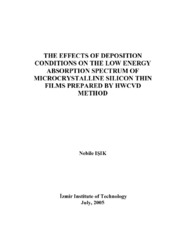Please use this identifier to cite or link to this item:
https://hdl.handle.net/11147/3839| Title: | The Effects of Deposition Conditions on the Low Energy Absorption Spectrum of Microcrystalline Silicon Thin Films Prepared by Hwcvd Method | Authors: | Işık, Nebile | Advisors: | Güneş, Mehmet | Publisher: | Izmir Institute of Technology | Abstract: | The optical and electronic properties of hydrogenated microcrystalline silicon films deposited by HWCVD method were investigated using steady state photoconductivity (SSPC), dual beam photoconductivity (DBP) and transmission spectroscopy methods to understand the effects of deposition conditions such as silane concentration and filament temperature on the low absorption coefficient spectrum, alpha (h.). The alpha (h.) spectrum obtained from the detailed optical calculation using the relative DBP and transmission spectra were compared with that independently measured on the same samples using photothermal deflection spectroscopy (PDS) and constant photocurrent method (CPM) techniques. The results were found to be in agreement with those of PDS and CPM at higher energy part of spectrum. On the other hand some differences exist among the spectra at lower energies. These differences were discussed to be consistent with underlying the physics of these methods.The effect of silane concentration on the sub-bandgap alpha (h.) spectrum was found to be substantial. At highest SC of 10% the alpha (h.) spectrum similar to that of a-Si: H is obtained. As SC decreases to 7%, microcrystalline phase becomes dominant.Further decrease of SC, the low energy alpha (h.) decreases and given a minimum around SC of 5%. For the lower SC.s, highly crystalline .c-Si: H films are obtained but the alpha (h.) values increases to higher values indicating an increase in the defect densities present in the microstructure.The effect of filament temperature was investigated for a constant SC of 10%. It was found that at 1700 C and 1800 C, fully amorphous films are obtained but 1800 C results in higher alpha (h.) values at lower energies. At 1880 C, microcrystalline phase becomes dominant and the alpha (h.) spectrum becomes similar to that of single crystal silicon.Finally, due to inhomogeneous microstructure of uec-Si: H, there are left fringes on calculated alpha(h.) spectrum on same samples. The degree of the inhomogeneity was investigated by front and back ac illumination of DBP measurements. It was found that there exists a substantial differences on the spectra measured on the same sample indicating importance of inhomogeneous film growth on optoelectronic measurements and its evaluation. | Description: | Thesis (Master)--Izmir Institute of Technology, Physics, Izmir, 2005 Includes bibliographical references (leaves. 81-86) Text in English; Abstract: Turkish and English xii, 99 leaves |
URI: | http://hdl.handle.net/11147/3839 |
| Appears in Collections: | Master Degree / Yüksek Lisans Tezleri |
Files in This Item:
| File | Description | Size | Format | |
|---|---|---|---|---|
| T000340.pdf | MasterThesis | 1.3 MB | Adobe PDF |  View/Open |
CORE Recommender
Items in GCRIS Repository are protected by copyright, with all rights reserved, unless otherwise indicated.